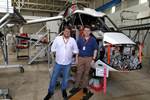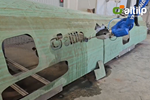Airbus video highlights RACER compound helicopter first flight
Launched as part of a Clean Sky 2 program, a compound design — rotor, split fixed-wing, propulsive propellers — uses composites to cut fuel consumption and emissions by 20%.
Airbus’ (Toulouse, France) latest report notes the first flight of the RACER helicopter has marked the beginning of a new era. Its hybrid design reportedly offers simple, elegant solutions to the technical challenges of high-speed helicopters while also advancing sustainable aviation.
Launched as part of the Clean Sky 2 program, now Clean Aviation, RACER’s objectives were ambitious: A 20% reduction in fuel consumption and CO2 emissions compared with conventional aircraft of the same weight, plus equally significant reduction in noise.
The key to RACER’s success in meeting these objectives lies in its compound architecture comprising distinctive fuselage aerodynamics, helicopter rotor, fixed wing and propulsive propellers. This is integrated with a engine power management and an autopilot that knows how to make the most of this combination.
The performance of the wing is also optimized in all phases of flight, thanks to the use of flaps placed on the trailing edge, contributing to reduced fuel consumption. By providing 40% of the total lift, the wing takes the load off the rotor, reducing dynamic loads and vibrations.
Composites feature heavily in the RACER’s construction, including the forward fuselage, detailed in the CW article, “Leveraging motorsports composites for next-gen rotorcraft” and the honeycomb-cored fuselage side shells in, “Optimizing AFP for complex-cored CFRP fuselage.”
For more information, read “Airbus Helicopters RACER demonstrator performs first flight.”
Related Content
-
A new era for ceramic matrix composites
CMC is expanding, with new fiber production in Europe, faster processes and higher temperature materials enabling applications for industry, hypersonics and New Space.
-
Sulapac introduces Sulapac Flow 1.7 to replace PLA, ABS and PP in FDM, FGF
Available as filament and granules for extrusion, new wood composite matches properties yet is compostable, eliminates microplastics and reduces carbon footprint.
-
The potential for thermoplastic composite nacelles
Collins Aerospace draws on global team, decades of experience to demonstrate large, curved AFP and welded structures for the next generation of aircraft.
















